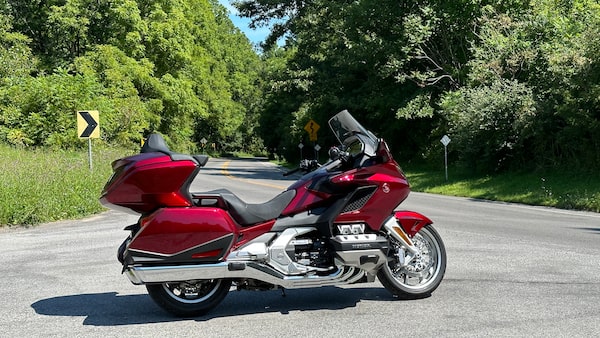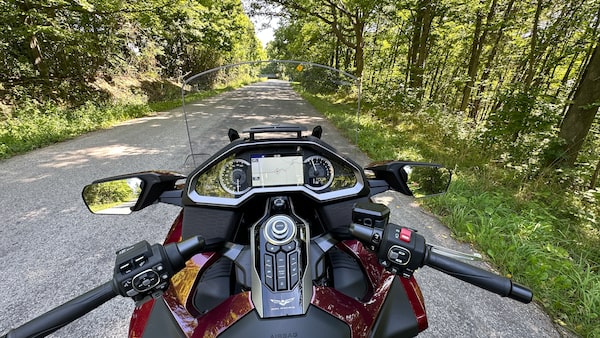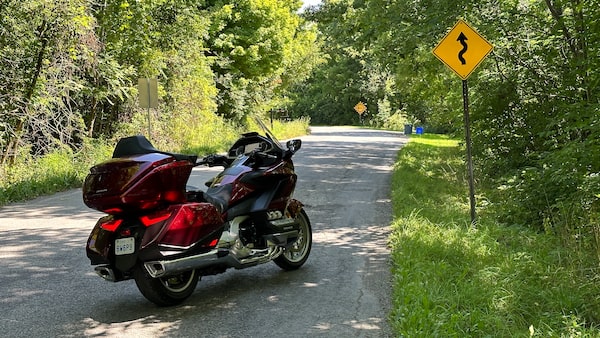
The cleverest thing about the bike is its inverted double-wishbone front suspension, which just laps up bumps.Mark Richardson/The Globe and Mail
There are plenty of jokes about the Honda Gold Wing motorcycle, and have been since the bloated behemoth first hit the road in 1975.
What’s the difference between a Gold Wing and a logging truck? About 20 kilograms and a stuffed animal. It’s a sofa on wheels, a Wingabago, a Hondapotamus.
Gold Wing owners didn’t care, and neither did Honda. The big motorcycle grew bigger, up to 1,100 cubic centimetres, then 1,200, then grew into a flat-six-cylinder engine with 1,500 cc, and finally, just to hit it right out of the park, 1,800 cc in 2001 (which is bigger than almost everything else on the market). The current model was introduced in 2018 as the Wing’s sixth generation and is the flagship of Honda’s international motorcycle fleet.
I’ve ridden most of the generations for extended periods, and most recently for a week late this summer. Since then, I’ve been scratching my head, trying to find fault with it and wondering if it really is the best motorcycle in the world.

The 2023 Honda Gold Wing has a seven-inch digital touchscreen and an electrically adjustable windscreen.Mark Richardson/The Globe and Mail
This year’s test bike was the most expensive version of the Gold Wing that’s available, costing $37,978 before tax and equipped with Honda’s dual-clutch transmission (DCT) and an airbag. There are very few motorcycles sold with any kind of automatic transmission, and the big Wing is the only bike with its own airbag. It’s a $2,600 option, but before you say you can’t put a price on safety, bear in mind you can buy a pair of high-quality motorcycle jackets with integrated airbags for around that same cost.
Also, while it’s a lot of money for something many would consider a seasonal plaything, it pales next to the cost of a $65,000 CVO Harley-Davidson, and is loaded with far more features than the similarly priced flagships of other motorcycle companies.
The joke, of course, is that the only thing that makes a Gold Wing a motorcycle is its two wheels. The bike’s many features seem taken straight from Honda’s (and Acura’s) car catalogue. Electronic suspension? Check. Tire pressure monitoring, new for 2023? Check. Hill start assist? Engine stop at idle? A seven-inch navigation screen? Check, check, and check.
In fact, the thing that makes the Gold Wing so exemplary is that it can take these many comfort and convenience features and still provide the motorcycle experience. It will happily lean far enough into the corners to scrape the footpegs – no bulky foot boards on a Wing – and it will even pop a wheelie under hard acceleration. All the while, the rider and passenger are cosseted by the most effective, electrically adjustable windscreen on the market, and powerful heated seats and heated hand grips. The Gold Wing really does extend the comfortable riding season right up to when the first snow stays on the ground.
I rode the test bike down to the Niagara Region from the other side of Toronto. Traffic was heavy in the city and I appreciated not needing to feather a clutch lever among the stop-and-go vehicles. If I owned a Wing, I’d go the whole hog and invest in this DCT system that provides an extra, seventh gear. It let me change gears manually with the flick of a button, or just leave it to the computer, though it was often clunky with its downshifts. There are four electronic ride modes, for Rain, Sport, Tour and Eco, that adjust the throttle, suspension and braking, as well as the traction control that’s improved for 2023.
Along the way, I hit construction zones where the asphalt was scraped up, with signs warning motorcyclists of the ridges in the pavement. Bikes with narrow tires will wobble on such a surface and it can be disconcerting to novice riders, but the Gold Wing’s tires and suspension never even noticed. The cleverest thing about the bike is its inverted double-wishbone front suspension, which just laps up bumps and keeps the vibration-free ride as smooth as a limousine.
I monitored traffic along the way with the Apple CarPlay that’s displayed on the digital touchscreen (Android Auto is also offered), and disabled the feature that turns off the engine after three seconds of idling. It’s an uncomfortable feeling to be sitting on a silent, non-running motorcycle in traffic, though the engine would fire to life with just a twist on the throttle.
So far, I could be describing a dull drive in a fully loaded Honda Civic Touring sedan, which is about $1,500 cheaper and has a smaller engine. But it was when I branched off onto some less-travelled roads on the Niagara Escarpment that I started thinking the Gold Wing might be the best motorcycle in the world.
I switched the ride mode to Sport and lowered the screen to enjoy the wind in my face. Much of the 21-litre gas tank is stored low, beneath the seat, so the centre of gravity is also low. This means the bike’s 390-kilogram weight actually feels much less – it’s certainly more easily manoeuvrable than other heavy touring bikes with conventional gas tanks above their engines. At one point, the road tapered off into an unmaintained track and yet I pressed on over the rocks and through the sand with barely a second thought.
I’m not suggesting the Gold Wing is as good as a dirt bike in the dirt, or a sport bike on the track, or even just a light and nimble naked bike on a country road. I’m saying that the Wing handled all these tasks way better than I expected, without fuss or incident. When it was time to go home, I just set the navigation for the main highway, turned on the cruise control and settled into the deep and comfortable seat for the final 250-kilometre stretch.
Even so, I don’t think I would buy a Wing. For me, a motorcycle should be as simple as possible, and the price tag is just too much to justify to my wife. I understand people who do buy them, however: They’re riders who want to be comfortable, and to get as much as they can for their money. If they can afford it, the Honda Gold Wing comes as close as any motorcycle can to giving them absolutely everything that’s possible on two wheels.

The most expensive Gold Wing is equipped with Honda’s dual-clutch transmission (DCT) and an airbag.Mark Richardson/The Globe and Mail
Tech specs
- Base price/as tested: $29,878 / $37,978, plus taxes
- Engine: 1,833 cubic-centimetre liquid-cooled horizontally opposed six-cylinder that produces 125 horsepower and 130 lb-ft of torque
- Fuel consumption (litres per 100 kilometres): 5.6 combined city and highway
- Alternatives: Harley-Davidson Road Glide Limited, BMW K 1600 GTL, Indian Roadmaster, Kawasaki Vulcan